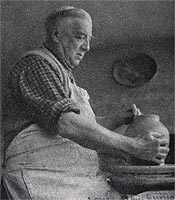
 Emile Lenoble, born in Paris on November 24, 1875, completed his studies at the Jean-Baptiste Say School.
Emile Lenoble, born in Paris on November 24, 1875, completed his studies at the Jean-Baptiste Say School.
At 18, he enrolled at the National School of Decorative Arts and then worked as a designer for industrial ceramist Loebnitz. The Lenoble family resided in Choisy-le-Roi, where Ernest Chaplet, the revitalizer of contemporary ceramics, had set up his workshops.
Their encounters initially took place along the banks of the Seine, while fishing, and around 1900 the old master started hosting young Lenoble. He taught him pottery and gradually introduced him to the secrets of the trade: Emile Lenoble's vocation was henceforth determined.
In 1905, he married Chaplet's daughter, shared his workshop, and exhibited his first works in 1906 at the Georges Petit Gallery alongside those of his father-in-law. In 1907, Chaplet died, and Lenoble permanently moved into his own workshop. His beginnings were challenging until Salomon Reinach commissioned him to create a tableware set for his Beaulieu villa, built by Pontremoli, where everything was in Greek style.
From this time onward, Lenoble started incessant and passionate material research, inspired by the teachings and experiences of his master. A founding member of the Artists' Decorators, Autumn, and Tuileries salons where he regularly exhibited, Emile Lenoble, whose art and personality played a pivotal role in French ceramics history, participated in all major exhibitions in France and abroad. Museums, including those in Paris, Petit Palais, Museum of Modern Art, and the Museum of Decorative Arts, sought to acquire his works with honor.
When Brittany, where he had sought refuge to escape, was invaded by the Germans, he could not bear the ordeal and died in Crozon on August 14, 1940. Emile Lenoble had been a Knight of the Legion of Honor since 1925.
We cannot talk about Emile Lenoble's art without mentioning everything he owed to his master, Chaplet, the genius craftsman. Chaplet was the first to love the earth for its own sake, to seek the erudite reactions of metallic oxides to adorn it, but also to return to it its "elementary" beauty, stripped of all decoration.
Chaplet was haunted, as Emile Lenoble would later be, by the austere magnificence of Chinese and Korean ceramics. He managed to recreate their powerful and solemn colors: ox-blood red, mule's liver, russet browns, purples, wine lees, and wonderful pure whites.
Emile Lenoble, though he used some simple decor - chevrons, Greek keys, interlaces, stylized foliage that he incised into the earth - was particularly fond of the rustic beauty of broad, generous shapes, akin to his own image, solid as a force of nature. The glazes of rare colors, the subject of his ceaseless research, he didn't want them to be mere superficial coatings, but incorporated with the earth. They formed, under the action of a kiln firing up to 1300°C, a new material with hidden splendors, even in the secret crevices of a pot or amphora: burning sea blues, tumultuous and bubbling like foam, rough and muted burnt bread, dense and hard blacks like a gemstone.
An always dissatisfied artist, Emile Lenoble ruthlessly broke all the pieces that didn't meet his passion, his ideal: they were humbly sent to "the pottery graveyard" where the precious shards of ceramics, porcelain, and discarded debris spoke of the struggle between man and fire, and the distressing drama of creation.
Photo : Sully / collection Rouard